Bulletin – March 2011 Household Borrowing Behaviour: Evidence from HILDA
- Download the article 163KB
Abstract
Over the 1990s and the first half of the 2000s, household debt grew strongly in response to lower nominal interest rates and innovation in the financial system. Since the mid 2000s, the pace of growth in borrowing has slowed significantly. Using household-level data, this article confirms that this slowing has occurred across all age groups. Following the global downturn and the decline in interest rates over 2008/09, there was also a sharp increase in the number of households reporting that they were ahead of schedule in their home loan repayments or paying off their credit card balance each month.
Introduction
Household debt grew strongly through the 1990s and the first half of the 2000s, rising from around 70 per cent of disposable income in 1996 to just over 150 per cent in 2006, before stabilising around this level over recent years (Graph 1). The run-up in household debt is largely accounted for by strong growth in housing-secured borrowing, with investment property loans increasing particularly rapidly in the early 2000s. An important factor explaining the rise in household debt was the structural fall in nominal interest rates following the transition to low inflation in the early 1990s, which raised the borrowing potential of households.[1] Financial deregulation during the 1980s also enabled greater competition in the market, expanding the availability of mortgage finance.[2] The emergence of mortgage originators in the 1990s boosted competition in the mortgage market, lowering interest margins particularly for investor housing loans.[3] Financial intermediaries also provided new products such as home-equity loans and offset accounts, making it easier for existing home borrowers to redraw from their mortgages.
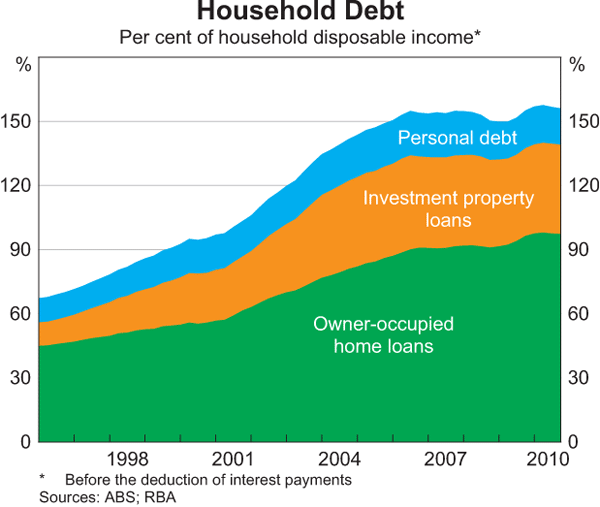
Since 2005, however, growth in household borrowing has slowed, particularly following the global downturn. Most of the analysis of this recent period has focused on the trends in the aggregate data. This article contributes to this analysis using data collected from individual households as part of the Household, Income and Labour Dynamics in Australia (HILDA) Survey. This survey is a panel study that began in 2001 with around 7,500 households drawn from the occupants of private dwellings in Australia. Since then, nine annual surveys have been released, with the most recently released survey completed in the second half of 2009. This latest survey is the first to measure the responses of households following the global downturn and the fall in interest rates in 2008/09. The survey collects detailed information on the income, wealth and labour market experiences of households, and also includes a series of questions on owner-occupied home loans (including home-equity loans) and credit card usage, which can be used to explore changes in borrowing behaviour over recent years.[4]
The Distribution of Owner-occupied Home Loans over the 2000s
The HILDA Survey confirms that over the past decade, an increasing share of owner-occupied home loans has been taken out by high-income households (Table 1). In 2009, the top 40 per cent of households in the income distribution held 73 per cent of the value of home loans, up from 69 per cent in 2001. This rising concentration of debt in high-income households is evident across all age groups, although it is particularly pronounced for younger households. Consistent with this, for households whose reference person is aged 15–34 years, the median income of those with home loans relative to those without home loans rose from 150 per cent to 180 per cent over the period.[5]
The share of older households (where the household reference person is aged 50 and over) with home loans has also increased (Table 1). Since the 1990s, older households have taken advantage of expanded access to their home equity by retaining debt for longer, consistent with rising life expectancy (Battellino 2006). The rise in older households' share of home loans does, however, appear to have slowed somewhat in the late 2000s.
| Per cent of households with home loans |
Per cent of the value of home loans |
||||||
|---|---|---|---|---|---|---|---|
| 2001 | 2005 | 2009 | 2001 | 2005 | 2009 | ||
| Percentile of income | |||||||
| Under 60 | 21 | 20 | 21 | 31 | 25 | 27 | |
| 60–100 | 50 | 55 | 55 | 69 | 75 | 73 | |
| Age of household reference person | |||||||
| 15–34 | 33 | 30 | 32 | 28 | 26 | 27 | |
| 35–49 | 52 | 54 | 54 | 55 | 52 | 48 | |
| 50 and over | 16 | 21 | 24 | 16 | 22 | 25 | |
|
Sources: HILDA Release 9.0; RBA |
|||||||
The home-loan-to-income ratio rose rapidly across all age groups over the first half of the decade, before slowing more recently, confirming the trend evident in the aggregate data (Graph 2). This indicates that the levelling-off in the home-loan-to-income ratio was not driven by the aging of the population and the increasing share of debt held by older households, who tend to have lower debt levels than younger households. In fact, the change in trend is clearest for younger households, with the median home-loan-to-income ratio rising from around 200 per cent in 2001 to above 300 per cent in 2006 before easing more recently. This has been mainly due to slower growth in borrowing by younger households over the period since 2006, along with faster income growth.
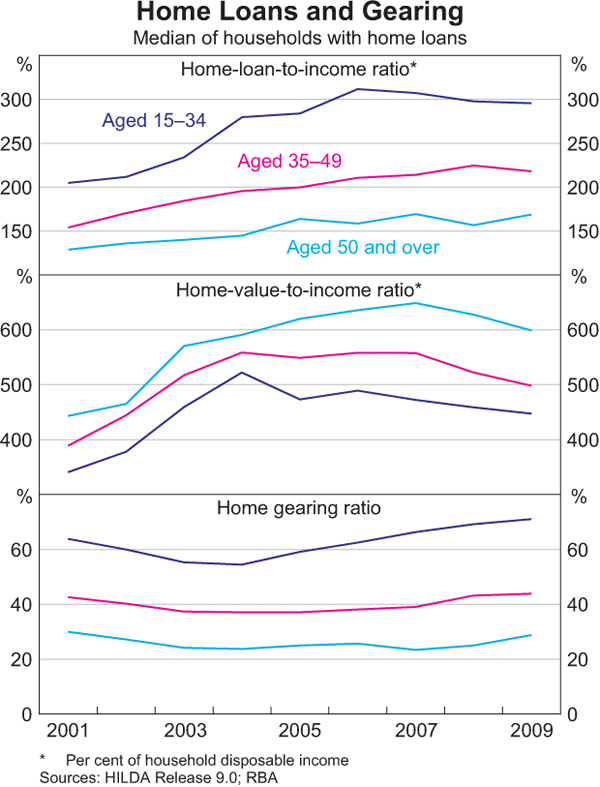
In contrast to the home-loan-to-income ratio, the home gearing ratio (the home loan relative to the home value) fell over the early 2000s before rising over the remainder of the decade, particularly for younger households. Younger households reported stronger growth in the value of their homes between 2001 and 2004 relative to older households. Conversely, from 2004 to 2009, younger households reported the slowest growth in their home values. This is consistent with trends over the decade in the prices of the less expensive dwellings more likely to be purchased by young first-home buyers. Combining the movements in home loans and values, the home gearing ratio fell in the early 2000s as house prices rose rapidly. Ellis, Lawson and Roberts-Thomson (2003) found that such an effect was largely mechanical, with households not necessarily adjusting their borrowing in the short run to maintain a desired gearing ratio following movements in house prices. Since 2004, with home values increasing more slowly than borrowing against the home, the gearing ratio for younger households has risen, although the rise has been more muted for older households. The rising gearing ratio for younger households could also reflect the higher incomes of those entering home ownership in recent years, with Kohler and Rossiter (2005) finding a positive relationship between gearing ratios and income.
The flattening in the home-loan-to-income ratio across all age groups since 2005 can be partly explained by slower growth in the size of new loans relative to income. The home-loan-to-income ratio on new home loans rose from around 220 per cent for households who moved into their home in 2000–2001 to almost 300 per cent for households who moved into their home in 2004–2005. Along with relatively high turnover in the housing market in the early 2000s, this increase in new loan size boosted aggregate growth in household borrowing. Since then, the size of new loans relative to income has increased only slightly (Graph 3).
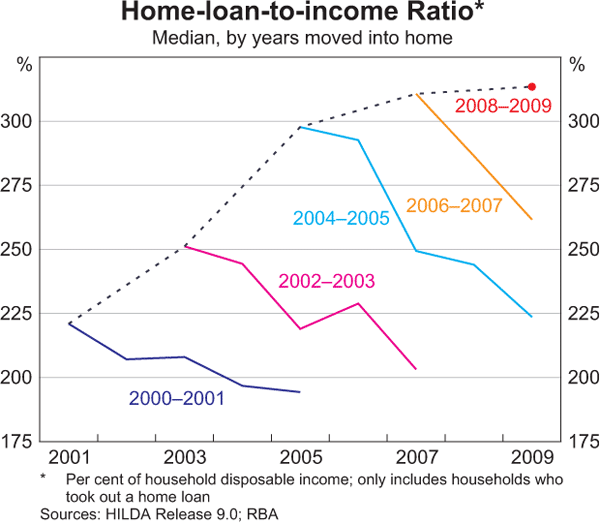
It appears that the home-loan-to-income ratios of households declined more quickly in the second half of the 2000s than earlier in the decade. For households who moved into their homes in 2000–2001, the home-loan-to-income ratio declined by around 25 percentage points over the following four years (Graph 3). In comparison, households who moved in 2004–2005 experienced around a 75 percentage point decline in their home-loan-to-income ratio over the same period. This has mainly been due to faster income growth since 2005, rather than larger declines in loan balances. This is not surprising since, with a typical home loan, lenders require households to make a constant minimum repayment over the term of the loan for a given interest rate; so early on in the term of the loan, repayments mainly cover interest with only a small fraction repaying principal.
The boom in purchases of investment properties in the early 2000s also influenced trends in the owner-occupied home-loan-to-income ratio. Property investors with owner-occupied home loans rose from 5½ per cent of households in 2001 to 7 per cent in 2004, with the largest increase among older households. Ellis et al (2003) found that investment property owners were more likely to have higher gearing on their owner-occupied homes. Consistent with this, the owner-occupied home-loan-to-income ratio of investors was 20 percentage points higher than for other borrowers in 2001, and this differential widened to around 50 percentage points by 2004 (Graph 4). Since then, growth in the number of investors with home loans has slowed, and the home-loan-to-income ratio of investors has not increased further relative to other borrowers.
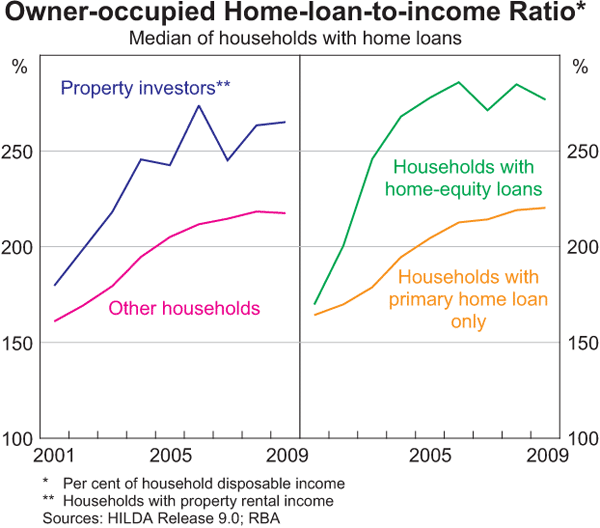
The borrowing behaviour of households with home-equity loans also changed around 2004. The home-loan-to-income ratio of households with home-equity loans rose much more sharply in the early 2000s than for households with just a primary home loan (Graph 4). During this period, the majority of home-equity loans were taken out by property investors, who may have been using these loans partly to finance their investment property purchases. A significant share of the funds raised through home-equity loans would have also been invested in financial assets or spent on consumer goods and services.[6] Since 2004, the home-loan-to-income ratio of households with home-equity loans has stabilised.
The Recent Increase in Debt Repayments
A range of indicators from the HILDA Survey suggests that household debt repayments trended down over the early 2000s, before stabilising from around 2005, and then increasing sharply in 2009. For instance, through the early 2000s, the proportion of households ahead of schedule on their home loan repayments declined steadily, with households' usual principal repayments falling relative to the home loan value (Graph 5). This trend was partly due to high turnover in the housing market in the early 2000s, which increased the share of borrowers who were in the early stages of paying off their loan, when the required principal repayments are a smaller fraction of the outstanding loan value.
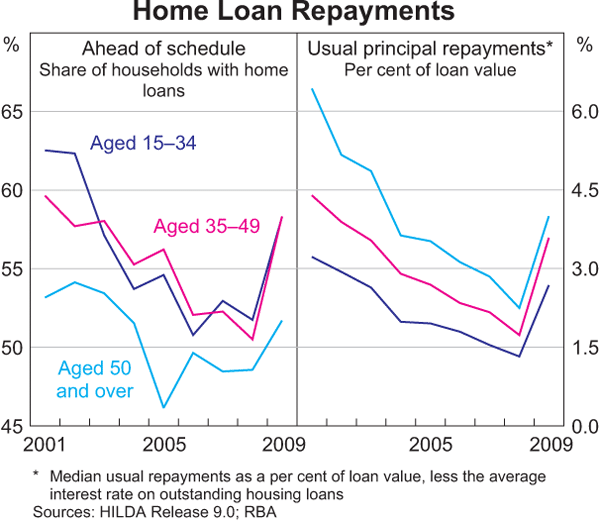
Rising interest rates from 2002 to 2008 would have also reduced the cash flow available to households to make excess repayments. The share of households reporting they were ahead of schedule was broadly flat from 2006 to 2008, before rising sharply in 2009, while usual principal repayments jumped to their highest rate since 2003 across all age groups.
The recent increase in repayments reflects lower home loan interest rates in 2009, which boosted the cash flow available for households to repay debt, as well as the elevated financial caution of households following the global downturn. In the HILDA Survey, almost half of the households reported that they did not lower their usual repayments between 2008 and 2009, despite home loans interest rates falling by almost 3 percentage points over the year. Consistent with RBA liaison with lenders, these households chose to use the extra cash flow provided by low interest rates to repay their home loans faster, which would be consistent with a response to the income uncertainty and wealth losses generated by the global downturn.
Households' medium-term repayment plans also suggest that households have sought to repay their debts more quickly over recent years. Previous work by Ellis et al (2003) found that households' expected pay-off dates contains useful information about household preferences that could help explain the gearing on their housing. When households that had recently moved into their homes were asked about the number of years they expected it would take to pay off their loans, their expectations lengthened between 2001 and 2006 (Graph 6). More recently, this trend has reversed, particularly in the older age group, where the expected length of time to pay off home loans has fallen noticeably.

The trend towards paying debt off more quickly is not limited to housing debt. After rising steadily for most of the past decade, the share of people reporting that they regularly use credit cards fell sharply in 2009, to the level prevailing in 2001 (Graph 7). Furthermore, since the mid 2000s, the share of regular credit card users paying off their credit cards every month has risen consistently, with the largest increase in 2009. This trend towards paying off credit cards in full each month has been particularly pronounced in the younger age group.
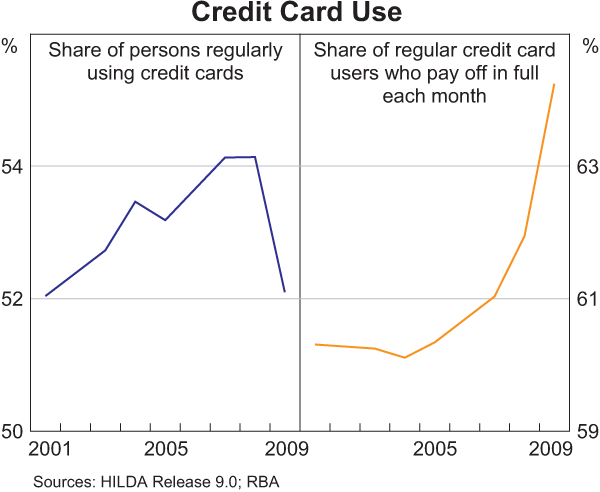
Conclusion
The growth of household borrowing has slowed over recent years. While the borrowing ability of households was boosted through the 1990s and the early 2000s by lower nominal interest rates and financial innovation, the associated transition to higher debt levels relative to income appears to have largely run its course. Consistent with this, household-level data from the HILDA Survey indicate that household borrowing has slowed since the mid 2000s across all age groups. This trend was accentuated in the 2009 survey, which showed a sharp increase in the number of households reporting that they were ahead of schedule on their home loan repayments or paying off their credit card balances in full each month.
Footnotes
The authors completed this work in Economic Analysis Department. [*]
Reserve Bank of Australia (2003) estimated that lower interest rates and inflation could explain roughly a doubling of the aggregate debt-to-income ratio, which is broadly consistent with what occurred between the mid 1990s and the mid 2000s. [1]
Ellis (2006) highlights that strong growth in housing credit associated with the transition to a low inflation environment and financial innovation was a trend experienced by many industrialised economies during the 1990s and early 2000s. [2]
For more detail on residential property investment in the early 2000s, see Parlett and Rossiter (2004). [3]
HILDA Release 10.0, scheduled for release in late 2011, will contain more comprehensive data on household debt and assets, which are included in the survey once every four years. [4]
The household reference person is the one most likely to be making financial decisions for the household, based on household relationships, income and age. [5]
For an analysis of housing equity withdrawal during the mid 2000s, see Schwartz et al (2006). [6]
References
Battellino R (2006), ‘Developments in Australian Retail Finance’, RBA Bulletin, September, pp 12–21.
Ellis L (2006), ‘Housing and Housing Finance: The View from Australia and Beyond’, RBA Research Discussion Paper No 2006-12.
Ellis L, J Lawson and L Roberts-Thomson (2003), ‘Housing Leverage in Australia’, RBA Research Discussion Paper No 2003-09.
Kohler M and A Rossiter (2005), ‘Property Owners in Australia: A Snapshot’, RBA Research Discussion Paper No 2005-03.
Parlett N and A Rossiter (2004), ‘Residential Property Investors in Australia’, RBA Bulletin, May, pp 52–56.
Reserve Bank of Australia (2003), ‘Household Debt: What the Data Show’, RBA Bulletin, March, pp 1–11.
Schwartz C, T Hampton, C Lewis and D Norman (2006), ‘A Survey of Housing Equity Withdrawal and Injection in Australia’, RBA Research Discussion Paper No 2006-08.